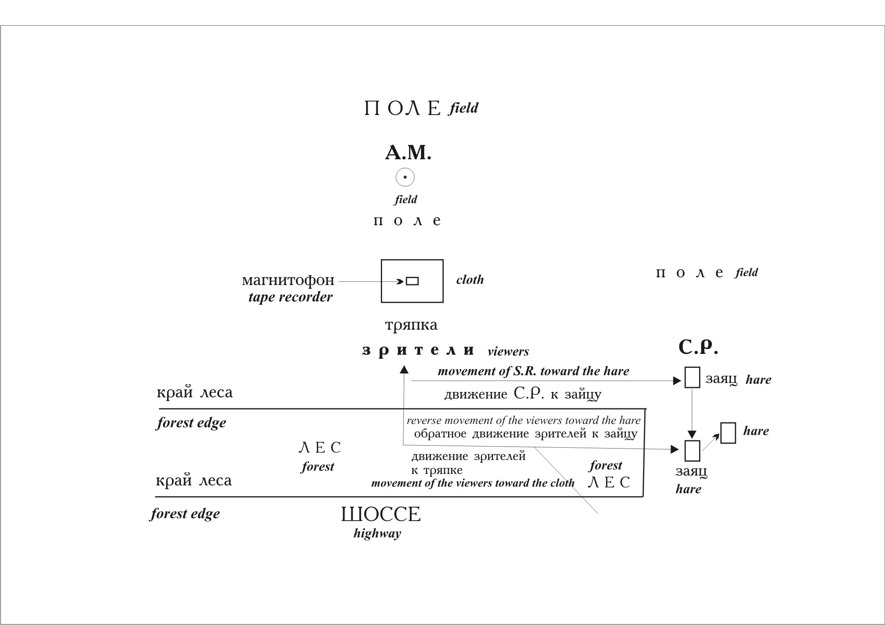KOLLEKTIVNYE DEYSTVIYA (COLLECTIVE ACTIONS). THE DESCRIPTIONS OF ALL THE ACTIONS, Photo and Video
JOURNEYS TO THE COUNTRYSIDE. VOLUME THREE
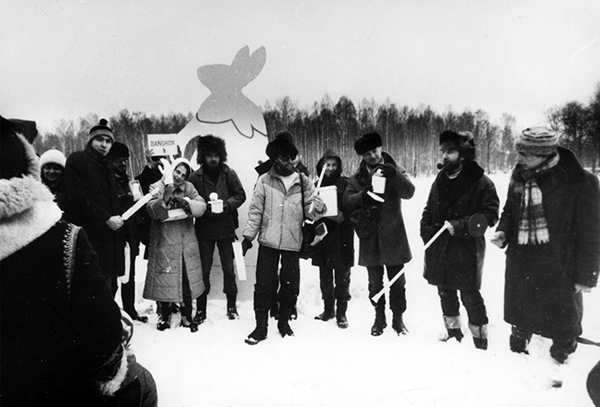
33. RUSSIAN WORLD
A group of viewers was met on the side of the highway by S. Romashko, who invited the new arrivals to proceed to the field along a prepared path through the deep snow. Notably, as the group made its way, Romashko followed behind. When the viewers came out onto the edge of the field and stopped in front of a purple cloth partly covered by a smaller white sheet (in the center of the whole thing was a tape recorder switched to play), Romashko turned off the path to the right and began to move through the snow along the line of the forest toward a plywood hare that we had earlier installed at the forest edge, around 70 meters from the audience. The hare (three meters tall) had been positioned facing the field so that its side was turned to the audience. From the position of the viewers, it resembled a pole protruding from the snow or a signboard.
While Romashko made the laborious way toward the hare, escaping the attention of the viewers (since he was moving along the edge of the forest and staying out of the group's line of sight), the audience listened to a recording of the sounds produced while constructing and installing the hare, recorded two hours prior to the action. Moreover, while Romashko made his way through the snow, the viewers could observe the motionless figure of Monastyrski in the field, around 70 meters from the purple cloth and facing them. Standing in position opposite the cloth and separated from the audience by a snowy expanse (Monastyrski had taken this position prior to the audience's arrival by a roundabout way so that there were no footprints in the snow between them), Monastyrski steadily wound a white thread onto the "soft handle," a prepared object made of a thick, round piece of cardboard with an elongated handle, on one side of which was glued an image of a clock face complete with hour and minute hands, while on the other was a red circle with a silver five-pointed star embellishment in the center. The disk's handle had previously been wound with 200 meters of white thread, so that the thread that was wound during the action was wound from another reel over the existing layer of thread. However, the distance between Monastyrski and the viewers prevented them from being able to make out either the "soft handle" or the process of winding the white thread onto it. The winding was perceived as the barely visible rocking motion of an indistinguishable object in Monastyrski's hands.
Around six or seven minutes after starting his movement, Romashko reached his position and began barely perceptibly, as though knocking the snow off his boots, to tap his feet on the lower part of the plywood hare. He gradually increased the intensity of his kicks, so that the sound attracted the attention of the audience. For three or four minutes, Romashko continued to increase the intensity with which he kicked the hare: first just with the toes of his boots, then with the entire soles, and finally, with a running start and kicking full force, knocking the hare down into the snow. After knocking over the hare, Romashko dragged it into the forest and disappeared from sight.
As soon as Romashko disappeared into the forest with the hare, Monastyrski turned the "soft handle" so that the red circle faced the audience (before this it was turned with the clock face toward the audience, but indistinguishable against the background of Monastyrski's coat). Having finished winding the rest of the thread (around one to two minutes more) Monastyrski started to move across the field toward the audience through the untouched snow. The snow was deep, and it took him no less than seven or eight minutes to reach the viewers. On reaching the purple cloth, Monastyrski picked up the tape recorder and put the "soft handle" red side up in its place. He then pulled back the white sheet to reveal nine white objects variously decorated with golden foil and wing-shaped golden embellishments. These objects were: 1) a glove, 2) an enema, 3) a walking stick, 4) a doll's head, 5) a clothes brush, 6) a rolling pin, 7) a toy ladder, 8) a black package containing a cardboard dripping pan, 9) a folder titled "The Book of Nothingness" (see accompanying photo and Monastyrski's article "TZI TZI"). These objects were then placed inside cardboard boxes with labels inscribed "C.A. The Golden Asp (followed by the object's name in parentheses)," and given to those viewers who held the pieces of cardboard with the corresponding object's name (distributed to them ahead of time). I. Kabakov received a separate tenth box labeled "C.A. The Golden Asp (the flask)" and was asked not to take out the flask (prior to being given to Kabakov, the box with the flask had been buried in the snow).
After this distribution of objects, the tape recorder with the sounds of the hare's construction was switched off and the viewers were prompted to make their way back to the highway.
Upon exiting the forest once again, the viewers found themselves on a snowy clearing facing a three meter tall white hare with a golden line drawn across its belly, symmetrically reflecting the outline of its head. Below the line was a label similar to those on the cardboard boxes: "C.A. The Golden Asp (the golden asp)."
After being photographed with the objects in front of the hare, the hare was knocked down into the snow and the viewers were invited to place the boxes on top of it. Then Romashko and Monastyrski dragged the hare along with the boxes into the field some ten or fifteen meters away from the audience. Monastyrski took the flask out of the box (the flask was painted white and filled with black gasoline), and broke it with the walking stick. The black gasoline flowed over the white objects and boxes. Then Romashko threw down a lit match, the gasoline ignited, and the boxes and objects burst into flames. At this moment, the tape recorder was switched on (it had been among the audience with one of the action's organizers), and began to play a recording of various railway station announcements, such as "Train so-and-so arrives at platform number so-and-so at such-and-such a time," (the recording was made at the Kursky railway terminal). When the objects on the hare had burned sufficiently, Monastyrski and Romashko began to throw snow over the fire and soon buried the hare entirely.
Moscow region, Savyolovskaya railway line, Kievogorsky field
March 17, 1985
A. Monastyrski, S. Romashko, E. Elagina, G. Kiesewalter, I. Makarevich, M.K.
Viewers:
I. Kabakov, V. Sorokin, I. Nakhova, I. Bakstein, N. Abalakova, A. Zhigalov, E. Zhigalova, M.Chuikova, S. Anufriev, E. Gorokhovsky, Nina, V. Naumets, V. Zakharov, D. Prigov, A. Prigov, Yu. Leiderman, G.Witte, S.Haensgen, I. and S. Kopystyansky, N. Alexeev
Translated by Yelena Kalinsky
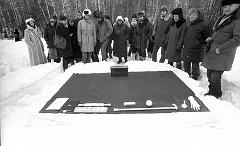 |
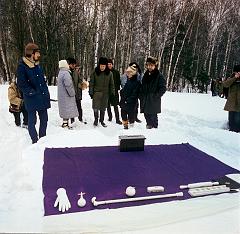 |
 |
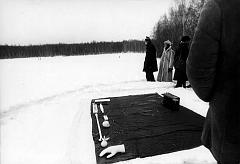 |
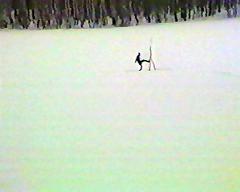 |
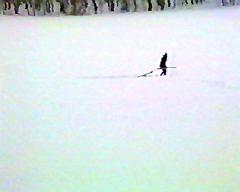 |
 |
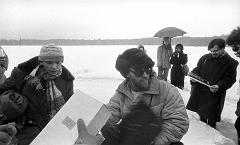 |
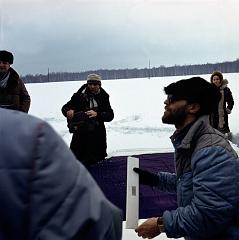 |
 |
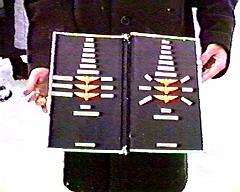 |
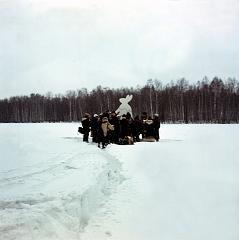 |
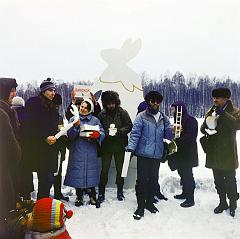 |
 |
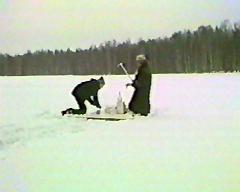 |
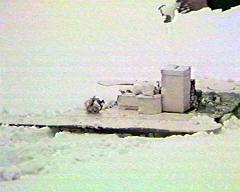 |
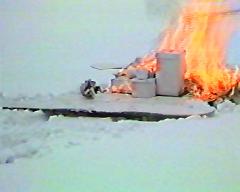 |
